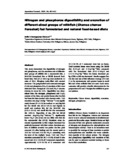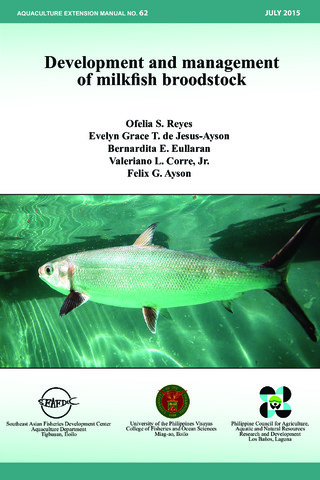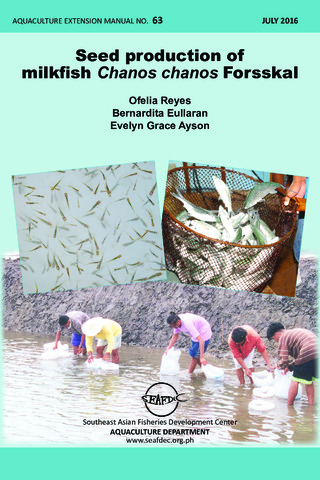Nitrogen and phosphorus digestibility and excretion of different-sized groups of milkfish (Chanos chanos Forsskal) fed formulated and natural food-based diets

ดู/
Request this document
วันที่
2003ผู้เขียน
Page views
195เมตาดาต้า
แสดงระเบียนรายการเต็มCited times in Scopus
Share
นามธรรม
This study determined the digestibility of nitrogen and phosphorus, and the excretion rate of different-sized groups of milkfish fed a commercial diet, a SEAFDEC formulated diet or lab-lab (natural food-based diet). Fish (31.2–263.0 g) were stocked in 12 units of 300-L fibreglass tanks filled with aerated seawater. The postprandial total ammonia-nitrogen (TAN) and phosphate (PO4-P) excretion of fish were estimated from changes in TAN and PO4-P concentrations in water for 24 h. Digestibility was determined from the nitrogen, phosphorus and Cr2O3 content of the diets, and pooled faeces after the fish had been fed diets marked with chromic oxide. TAN excretion rate (mg TAN kg−1 fish day−1) was significantly lowest (P < 0.05) in medium to very big fish fed the lab-lab diet (60.8–124.4) and highest in small and medium fish fed the SEAFDEC diet (333.3–331.6) and small fish fed the commercial diet (280.1). Regardless of size, fish fed lab-lab excreted (mg PO4-P kg−1 fish day−1) significantly lower PO4-P (36.2) but did not differ with fish fed the commercial diet (64.8). Excretion rates decreased exponentially as fish weight increased but positively increased with feed ration. Excretion pattern of milkfish revealed two peaks: the first peak occurred 6 h after feeding and the second peak at 18 h for TAN and 21 h for PO4-P, coinciding with the start of the daylight hours. TAN and PO4-P excretion accounted for 20.5–34.6% of total N consumed and 18.7–42.6% of P consumed respectively. Approximately 27.9–42.5% of N consumed and 47.2–58.5% of P consumed were lost as faeces. Total nutrient losses were lower using the lab-lab diet (0.31 g N and 0.14 g P kg−1 fish) compared with the formulated diets (0.47–0.48 g N and 0.17–0.19 g P kg−1 fish); the losses decreased per kg of fish as fish size increased. Results suggest that the diet and size of fish influence wastage of N and P to the environment with greater losses in small fish and when artificial diets are used. Such measurements will provide valuable information for the preparation of N and P budgets for milkfish in grow-out systems.
การอ้างอิง
Sumagaysay-Chavoso, N. S. (2003). Nitrogen and phosphorus digestibility and excretion of different-sized groups of milkfish (Chanos chanos Forsskal) fed formulated and natural food-based diets. Aquaculture Research , 34(5), 407-418. https://doi.org/10.1046/j.1365-2109.2003.00824.x
เรื่อง
Taxonomic term
คอลเลกชัน
- AQD Journal Articles [1214]
รายการที่เกี่ยวข้อง
แสดงรายการที่เกี่ยวข้องตามชื่อผู้แต่งผู้สร้างและเรื่อง
-
Annual report 1977
Southeast Asian Fisheries Development Center, Aquaculture Department (Aquaculture Department, Southeast Asian Fisheries Development Center, 1978) -
Development and management of milkfish broodstock
Reyes, Ofelia S.; de Jesus-Ayson, Evelyn Grace T.; Eullaran, Bernadita E.; Corre Jr., Valeriano L.; Ayson, Felix G. (Aquaculture Department, Southeast Asian Fisheries Development Center, 2015)The manual provides developed and refined techniques for collection and transport of spawned eggs and larvae, as well as larval rearing. It also describes the necessary facilities for maintaining milkfish broodstock. Guidelines ... -
Seed production of milkfish Chanos chanos Forsskal
Reyes, Ofelia; Eullaran, Bernadita; Ayson, Evelyn Grace (Aquaculture Department, Southeast Asian Fisheries Development Center, 2016)A 26-page manual describing the site selection, hatchery design, spawning, larval rearing, natural food production, and economic analysis for milkfish.





